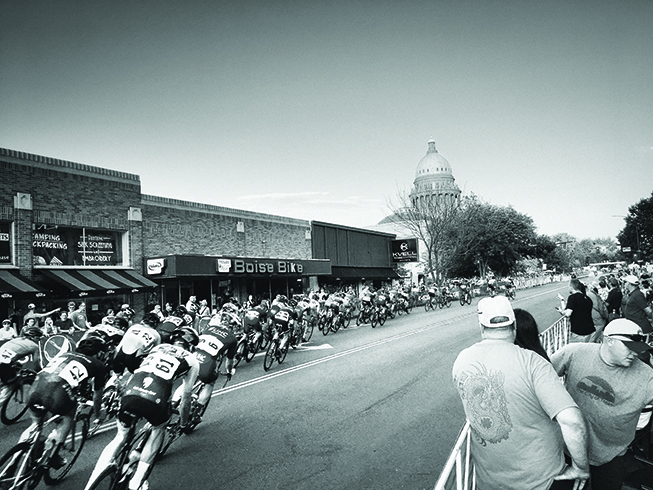For Boiseans, Christmas in July comes in the form of the Twilight Criterium. Instead of buzzing around the Capitol Christmas tree, however, crowds gather in Capitol Park to watch amateur and professional cyclists swarm through the streets. The whirring of tires and clanging of cowbells mixes with the sounds of cheering and announcers calling out the riders and their positions.
The Twilight Criterium is a one-day bicycle race that takes place on a circuit road course in downtown Boise every July. This year the event takes place July 14.
Criteriums have high speeds (around 35 mph) and close quarters, with approximately 75 riders in each heat. The fastest rider doesn’t necessarily make the winner, with teams of cyclists jockeying between their roles for ultimate racing strategies. For example, various team members will “attack” the racing group, causing other teams to “chase.” Primes (pronounced preems)—cash prizes for the rider who crosses the start/finish line first on a particular lap—keep the crowd and riders engaged.
Now in its 32nd year, the race starts and ends in front of the Capitol steps, with a picturesque backdrop that says as much about the race as the race says about Boise. Riders circle the track between 6th and 9th streets and Bannock and Jefferson, vying for first position and prize money. The top prize is $30,000, and it is split equally between the first place female and male riders.
Mike Cooley has organized the race since its inception. He got the idea after the first Ore-Ida Women’s Challenge in 1984 and the 1986 National Cycling Championships. Those races proved Boise was primed for a major cycling event. He was the proud new owner of George’s Cycles, which he and business partner Tom Platt purchased in 1981. He saw how successful the races were at showcasing Boise’s local cycling talent. First Security Bank, which later merged with Wells Fargo, offered to sponsor if Cooley could put it together, and he got to work.
Armed with caution tape and string lights borrowed from Morrison-Knudsen’s Christmas decorations, Cooley crafted an urban route that passed through the bar district on 6th and Main. He needed a crowd, after all, and that was the most populated area of downtown at 10 p.m.
Since then, Cooley has teamed up with the Downtown Boise Association (DBA) to organize the event, the track has moved locations, and it has grown into an all-day family-friendly affair, which Lynn Hightower, DBA’s executive director attributes to Boise’s community-focused culture. “For Boise, it’s more than a bike race. It’s bringing the community together and making people feel connected,” she said.
Race day begins with Kristin Armstrong’s kids ride at 1 p.m. and culminates with the women’s pro race at 7 p.m. and the men’s pro race at 8:15 p.m. Amateur cyclists can compete in the category 4/5 race at 1:45 p.m., which is a 45-minute sprint around the track. Other highlights include a paracycle race at 5:45 p.m. and a GreenBike celebrity bike ride at 6:15 p.m.
Local cyclist Robert Hoene has raced in every single Twilight Criterium since the first one in 1986. While he says the race has certainly gotten more organized, the reason he keeps riding in it remains the same.
“It’s very community oriented; that’s really what keeps me coming back,” he said. “For the amount of time we put in, a criterium is an opportunity for those around you to actually see you [compete] for a period of time … It’s a fun time to share with family and friends.”
With a top-tier position in USA Cycling’s criterium series, Boise’s Twilight has brought world-class cyclists from across the globe to the City of Trees for its race, including Olympians and Tour de France riders. This year, two additional events have made it a can’t-miss event: the inaugural Chrono Kristin Armstrong time trial on July 13, which is named for the three-time Olympic gold medalist and two-time world champion from Boise in the time trial event, and the Chicken Dinner Road Race on July 15.
Union Cycliste Internationale (UCI), the world governing body for sports cycling, will sanction the time trial, and the $35,000 prize money will be split down the middle between men and women. The Chicken Dinner Road Race will cap the weekend, where riders will compete on a 21-kilometer loop through the Snake River Valley. Cooley says the multi-event weekend will incentivize top riders from all over the world to make the trip as pressure mounts from other competitions.
Spectators can gather in Capitol Park this year to enjoy the shade, beer garden, and food trucks. Should you find yourself lost, listen for longtime announcer and former participant Kurt Holzer’s voice as he tries to relay the strategies of the teams and prime prizes that sponsors offer throughout the race.

